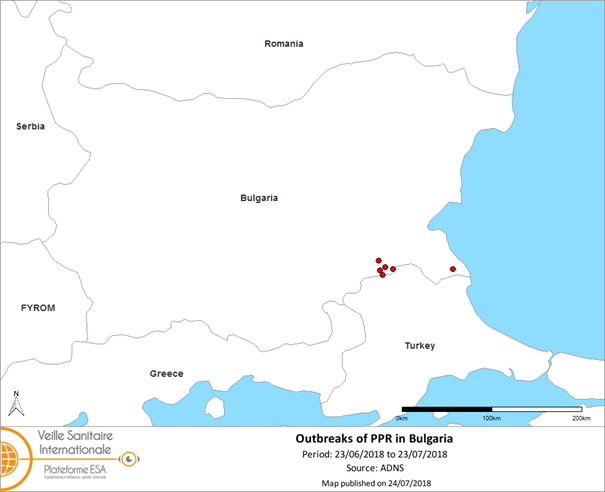Reported outbreaks of peste des petits ruminants in Bulgaria
For the Epidemic Intelligence team (VSI) (in alphabetical order): Anne Bronner (DGAL), Didier Calavas (Anses), Julien Cauchard (Anses), Sylvain Falala (Inra), Alizé Mercier (Cirad)
With the European Union Reference Laboratory (EURL) for peste des petits ruminants (Cirad)
Corresponding author: plateforme-esa@anses.fr
Sources: Animal Disease Notification System (ADNS) of the European Commission, report from Bulgarian authorities presented to PAFF (Plan, Animals, Food and Feed) committee meeting on 12/13 July 2018 (https://ec.europa.eu/food/sites/food/files/animals/docs/reg-com_ahw_20180712_pres_pdpf_bul.pdf), OIE WAHIS database (http://www.oie.int/wahis_2/public/wahid.php/Reviewreport/Review/viewsummary?reportid=27029)
On 19th July, Bulgarian authorities reported a new outbreak of peste des petits ruminants (PPR) in Yambol region (source: ADNS). The Bulgarian reference laboratory confirmed the outbreak on 18th July within the framework of the surveillance carried out in 3 and 10 kilometer restriction zones that were established around the PPR outbreaks in Boliarovo municipality. Control and eradication measures were implemented according to Directive 92/119/EEC.
As of 23rd July 2018, a total of seven PPR outbreaks involving nine herds have been reported to European authorities by Bulgarian authorities (source: ADNS) (see Figure 1). The last outbreak has not yet been notified to OIE. Of those seven outbreaks, five were detected following the collection of samples in the 3 and 10 kilometers restriction zones established around the PPR outbreak reported in Yambol region.
The first PPR outbreak in Bulgaria was reported on 23rd June in three herds from the village of Voden, Boliarovo municipality, Yambol region, located 10 kilometers from the Turkish border. The PPR virus was detected by the Bulgarian national reference laboratory and confirmed by European Union Reference Laboratory (EURL, Cirad) in three herds (380 sheep and 160 goats in total, 2 infected sheep of which 1 died) pasturing in close contact. Control and eradication measures were taken, as set in Directive 92/119/EEC, in particular the stamping out of the infected herds, including preventive culling of all other small ruminants reared in the village (only backyards, 667 sheep and 171 goat, in total), the establishment of protection and surveillance zones, and animal movement restriction (source: ADNS).
A second outbreak was reported on 28th June in a herd of 9 goats and 151 sheep (of which 10 sheep were infected) in the village of Kosti in the Burgas region in the East of the country. This new infected region is located 160 kilometers from the first three infected herds in Yambol region. This raises the question of the origin of this second outbreak, whether there is a link to the first outbreak or if there were multiple introductions from Turkey.
Figure 1: PPR outbreaks reported in Bulgaria as of 23rd July 2018 (source: ADNS) (Note: some outbreaks are overlapping on map due to geographical proximity)
It is now important to investigate the possible spread of the disease. Other samples will be collected from slaughtered animals as well as live animals with no clinical signs located in the 10-kilometer restriction zone around reported outbreaks.
For further information on peste des petits ruminants, see the OIE disease card available at http://www.oie.int/fileadmin/Home/eng/Animal_Health_in_the_World/docs/pdf/Disease_cards/PESTE_DES_PETITS_RUMINANTS.pdf

